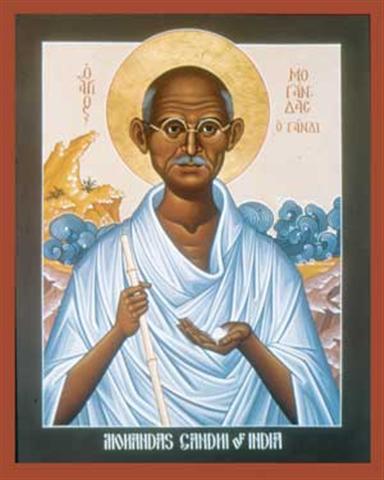« Read other entries… »

Gandhi, Sustainability and
Creative NonviolenceYou probably heard the phrase that for every action there is a reaction. This is so true for working in the garden. You take action and make a pile of leaves and coffee grounds and the reaction from the mix makes compost. You take action and put worms into a box of compost and the reaction is castings.
Today finishing the brochure for the creative nonviolent action tomorrow I find this theory is also true in creating brochures. Last night one of the team suggested I put the word “Iraq” before a statement saying, War is Immoral and Unjust. I took the action and was careful to check that any words in the paragraph below were not eliminated. What I did not check was the line above this heading. The reaction of this action of adding this word was the dropping of the last line in the paragraph above. Of course my wife noticed this tonight after I had 500 copies of the brochure printed.
The action tomorrow at Marquette University to close the School of Military Science on campus that recruits and trains young men and women for an unjust war has already caused a reaction. A number of MU radical conservative students are planning a reaction protest to our action. We hope to not react to their action but respond in the spirit of creative nonviolence with love and concern.
This morning a friend and I were planning our peace pilgrimage to walk in the footsteps of Mahatma Gandhi. Gandhi, like all masters of nonviolence, deeply understood the laws of action and reaction. Judith Brown in her book on Gandhi defines his Satyagraha or creative nonviolence as striving nonviolently to the point of sacrifice rather than fighting to attain ones vision of truth. In other words it is better to suffer than to react.
It is no surprise to me that Gandhi was great proponent of what we now call sustainability. I ran across a quote this morning from him about how wonderful it was to take the waste of cow manure and turn it into rich compost for plants. On our pilgrimage one of the stops is to observe cow-based agriculture. Hindus do not eat cows but they certainly use them in agriculture.
Gandhi also said You must be the change you wish to see in the world. An Indian Jesuit once told us: The way to peace is to work for peace. Here is another law of nature we can take from the garden.
If our actions tomorrow are ones for peace and we do not react to insults or actions of disdain, all will be able to see truth. Martin Luther King put this nonviolent reaction to an action of violence in his letter from the Birmingham jail this way: …disciplined nonviolence totally confused the rulers of the South. They did not know what to do. When they finally reached for clubs, dogs and guns, they found the world was watching, and then the power of nonviolent protest became manifest.
Yes for every action there is an reaction, but when the action or reaction is one of nonviolence, the reaction calls for more nonviolence. The way to peace is peace.
Comments
(:commentboxchrono:)